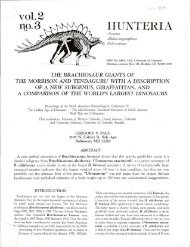THE MANY MYTHS, SOME OLD, SOME NEW, OF ... - Gregory S. Paul
THE MANY MYTHS, SOME OLD, SOME NEW, OF ... - Gregory S. Paul
THE MANY MYTHS, SOME OLD, SOME NEW, OF ... - Gregory S. Paul
You also want an ePaper? Increase the reach of your titles
YUMPU automatically turns print PDFs into web optimized ePapers that Google loves.
DINOSAUR <strong>MYTHS</strong> 87<br />
under normal circumstances. Guthrie (1990) shows that certain features of some<br />
ungulate horns are often designed to severely wound opponents of their own species.<br />
As shown above, heat radiation is not as important as often thought, and it is<br />
probably not the driving force behind dinosaur horns, clubs and spikes, although<br />
they could be used for such purposes. The horns of most ceratopsids are very long,<br />
sharp, dangerous weapons, well designed to wound attacking predators. The single,<br />
non-interlocking nasal horns of many species were also good for seriously injuring<br />
opponents during intraspecific combat. The tail spines of Stegosaurus were arrayed<br />
in a pin cushion fashion that enhanced their wounding ability (<strong>Paul</strong> 1987a). Ankylosaur<br />
tail clubs had sharp dorso-Iateral rims that would have enhanced the effect of<br />
their impact. Ankylosaur armor is most similar to the protective cuirasses of<br />
glyptodonts and turtles.<br />
PACHYCEPHALOSAURS BUTTED HEADS, NOT PREDATORS<br />
Myth: Pachycephalosaurs butted their heads together at high speeds.<br />
Reality: Such classic domeheads as Stegoceras and Pachycephalosaurus lacked any<br />
co-locking devices to help stabilize their head upon impact. Instead, the round<br />
domes would have bounced off each other erratically like billard balls, placing<br />
dangerous lateral torques on the neck. This suggests they instead rammed the sides<br />
of their opponents, including predators.<br />
ARCHAEOPTERYX HUNTED DRAGONFLIES AND<br />
BUTTERFLIES<br />
Myth: Protobirds were terrestrial hunters of flying insects that learned to fly by<br />
leaping after insects (as proposed by Caple et al., 1983). A number of recent<br />
illustrations have taken this to the extreme of showing Archaeopteryx chasing<br />
dragonflies, others show it chasing butterflies or moths.<br />
Reality: It is unfortunate that the question of the origin of bird flight has entrenched<br />
itself into two camps-one favoring arboreal gliding, the other terrestrial leapingbecause<br />
interbranch leaping would result in the improvement of aerodynamic<br />
control surfaces seen in the terrestrial leaping scenario. The latter scenario suffers<br />
from a lack of any living analogues, and it may be unfeasible for energetic reasons<br />
(<strong>Paul</strong>, 1988a). As for hunting dragonflies, they are perhaps the supreme insect<br />
aerialists in terms of speed and agility. Even high performance birds have great<br />
trouble pursuing them. Archaeopteryx and other proto birds would have been<br />
hopelessly outmatched, and restorations of them hunting dragonflies are most<br />
unrealistic. Jurassic proto birds could not pursue moths and butterflies, because these<br />
insects did not appear until the Cretaceous (Crepet and Friis, 1987).<br />
FLYING IS SO VERY HARD TO DO<br />
Myth: Most vertebrates get around in one or more of three ways, swimming,<br />
walking, and flying. These locomotory modes evolved in this order, and it is<br />
generally believed that swimming is the easiest, and flight the most difficult, ofthem.<br />
Reality: Swimming is easy, slow, sprawling gaits are relatively unchallenging, and









